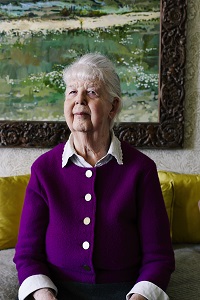Obituary: Shirley Hughes
Shirley Hughes
6 July 1927 – 25 February 2022
Nicholas Tucker remembers Shirley Hughes.
 Shirley Hughes, who has died aged 94, always brought joyous energy to her work. Sole creator of over fifty picture books, and the jobbing illustrator to innumerable other titles, she excelled at creating infant characters as bouncy as the real thing. Selling over twelve million copies of her books, she was a greatly respected figure in the publishing world and immensely popular outside it.
Shirley Hughes, who has died aged 94, always brought joyous energy to her work. Sole creator of over fifty picture books, and the jobbing illustrator to innumerable other titles, she excelled at creating infant characters as bouncy as the real thing. Selling over twelve million copies of her books, she was a greatly respected figure in the publishing world and immensely popular outside it.
The youngest of three sisters, Shirley grew up in the comfortable suburbs of Liverpool. Her Welsh Methodist father Thomas J Hughes, a man of formidable energy, owned the largest departmental store in town. Subsequently raised by her widowed mother after his early death, Shirley experienced what she later described as a ‘rather buttoned-down childhood’, with much time spent reading, drawing and playing intensely imaginative games with her sisters.
In 1946 she transferred to the Ruskin School of Drawing and Fine Art in Oxford, where she briefly lived next door to J R R Tolkien. She eventually turned to book illustration with commissions soon following, most notably illustrations for later editions of Dorothy Edwards’ series My Naughty Little Sister. Making use of skills she had developed through the habit of sketching when and wherever she could, Shirley was the ideal choice for giving shape to the fictional little sister and her friend Bad Harry. Having observed how ‘small children move, squat down when absorbed in a game, roll about or curl up in sleep’, she provided line drawings that perfectly matched the affectionate realism of the stories.
Shirley’s breakthrough as author-illustrator arrived with Lucy and Tom’s Day (1960). Now she could control every aspect of a book, sharing the story line between text and illustration. Designing the whole work with her characteristically filmic imagination, she drew her characters from every possible angle, switching between wide tracking shots, aerial views and close-ups. Starting off from rough drawings done quickly to preserve spontaneity, her illustrations describe the domestic highs and lows in one day of the lives of two small children. These young characters with their stumpy legs, creased clothes and untidy hair were realistic to a level seldom seen before in picture books. With their mums pushing buggies loaded with shopping and wearing baggy jumpers and jeans or leggings, the inhabitants of this new, urban world also represented a conscious break from the former dominance of home county settings in children’s illustrations, largely peopled by leisured middle-class characters. Children were now pictured in ordinary domestic mode, getting up in the morning, consuming meals, accompanying their parents shopping or to the park and, above all, playing.
Tom and Lucy went on to star in numbers of other picture books. But Shirley’s biggest success came with Dogger (1977) winning her the Kate Greenaway Medal for the outstanding picture book of the year. Drawing on her knowledge of her local London surroundings, this book satisfied at every level. In 2007, thirty years later, Dogger won another award, this time for the best book ever to have won that much-coveted Medal. Another great success was Alfie Gets in First (1981), within which four-year-old Alfie accidentally locks himself into the family home. Much pleading through the letter box follows, with Alfie’s increasingly distressed mother backed up by growing numbers of passing tradesmen. Shirley ingeniously converted the ‘gutter’ running down the centre of a two page spread into the wall separating the little boy from all the activity on the other side. Tousle-haired Alfie and his toddler sister Annie Rose went on to have many more mini-adventures, often involving their kindly neighbours Mr and Mrs MacNally and their baby-sitting daughter Maureen.
Married to the architect John Vulliamy in 1952 and living in London’s Notting Hill Gate in a Victorian terraced house overlooking a large communal square, Shirley preferred not to use her own three children as models. Instead she drew the kids she saw playing outside her window, eventually creating characters made up from innumerable individual sketches. In 2003, Ella’s Big Chance, an ingenious re-working of the Cinderella story set in the 1920s, provided Shirley with her second Kate Greenaway Award.
Stately in appearance, continuing for years to make her own clothes on a hand-cranked Singer, Shirley spoke with the well-rounded vowels of someone required to take elocution lessons when young. Her high intelligence and wide range of interests are both on show in her generously illustrated autobiography A Life Drawing; Recollections of an Illustrator (2002). She continued to live a busy life after the death of her beloved husband in 2007, illustrating the Prime Minister’s Christmas card for that year with a beaming group of cheerfully untidy youngsters. Preferring realism to fantasy and happy to reassure young readers rather than scare them, she remained loved as well as popular during all her working life, and will be much missed.




